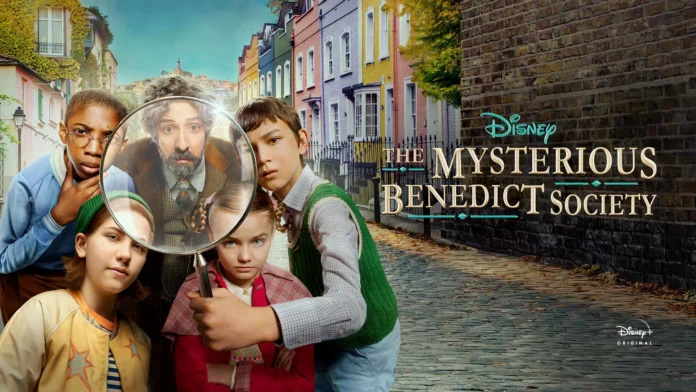The Mysterious Benedict Society, an American mystery-adventure television series based on a quartet of children’s books by Trenton Lee Stewart, is an assuaging treat for both children and adults alike. It feels like an all-around show that piques your and your family’s interest at a time when only a few movies and shows suited to the needs of people of all ages are produced.
The series stars Tony Hale as Mr. Nicholas Benedict, who creates a society of four children to stop a global emergency. Hale also plays Benedict’s twin brother, Mr. L. D. Curtain, whose philosophies serve as the series’ antagonist.The first (June 2021) and second (October 2022) seasons of the series premiered on Disney+.
Curtain creates an artificial state of emergency and anxiety in people in the first season, but in the second season he uses a method to induce artificial happiness in humans.Hence, the drawbacks of scientific technology (its shortcomings and its wrong use in the hands of malevolent forces), among other significant issues, have been highlighted in both seasons. Due to the multiple facets of this series, it would be worthwhile to suggest it.
The four main kid characters are: Reynie Muldoon (played by Mystic Inscho) is logical, thinks critically, and is good at solving puzzles; George Washington (played by Seth Carr) has an eidetic memory and is a walking encyclopaedia of geography; Kate Wetherall (played by Emmy De Oliveira) is athletic and audacious, always carrying a red bucket of useful tools; and finally Constance Contraire (played by Marta Kessler) is reticent, incredibly stubborn, and has psychic powers to read minds.
One main thing in the series is the representation of orphans and their psychological situation—how orphans crave love, appreciation, and attention while also going through trauma and anxiety. L. D. Curtain gets separated from his twin brother at an orphanage, and his inner trauma and yearning for love manifest themselves in his becoming a malefactor. And later, whatever he does is to gain the attention and appreciation of people, especially his brother. Similarly, all four kids are orphans, and their loneliness has been depicted in the first season.
Secondly, the significance of family, friendships, and teamwork in the series serves as a lesson for the young audience. The four very disparate kids come together to form an unlikely but strong bond, and with the elders of the Benedict Society, they form a family of their own.
Also, the scientific technology and hypnotization used for slipping anxious or happy emotions or thoughts into people’s minds in the series kind of reminds us of Michel Foucault’s discursive practices, or Antonio Gramsci’s hegemony, or Louis Althusser’s interpellation, according to which the state (or some entity) imposes its thoughts upon the citizens, who, on the contrary, think that they are freely choosing them.
The overall aesthetics of the series are satisfying with the use of specific bright, popping colour combinations that catch your eye instantly. The musical theme of the series is intriguing too. The setting takes you to some sunny European town with its narrow streets, little, colourful houses, and open green-gold fields of the countryside. To conclude, the series works on a number of imperative issues while at the same time being quite appealing to most of the viewers.


Quality content is the key to be a focus for the people
to visit the site, that’s what this web site is providing.
Feel free to visit my blog: vpn special code
What’s up, its good paragraph concerning media print,
we all be aware of media is a enormous source of
facts.
Here is my web-site … vpn code 2024
Please let me know if you’re looking for a writer for your blog.
You have some really great posts and I feel I would
be a good asset. If you ever want to take some of the load off, I’d love to write some articles
for your blog in exchange for a link back to mine.
Please send me an e-mail if interested. Cheers!
my website; vpn special code
Exceptional post but I was wanting to know
if you could write a litte more on this subject? I’d be very thankful if you could elaborate a little bit more.
Cheers!
my homepage – vpn special coupon code 2024
My brother recommended I may like this website. He used to be totally right.
This post actually made my day. You can not imagine simply how so much time I had
spent for this info! Thank you!
Also visit my blog vpn coupon code 2024
Good post. I learn something new and challenging on sites I stumbleupon every day.
It will always be interesting facebook vs eharmony to find love online read through articles from
other writers and practice something from their sites.
Hey There. I discovered your blog using msn. That is a very
neatly written article. I’ll make sure to bookmark it and come back to learn more of your
helpful info. Thank you for the post. I’ll definitely comeback.
Feel free to surf to my web site eharmony special coupon code 2024
Good way of describing, and good paragraph to get facts
concerning my presentation topic, which i am going to deliver in college.
Here is my web site :: nordvpn special coupon code 2024
Your point of view caught my eye and was very interesting. Thanks. I have a question for you.